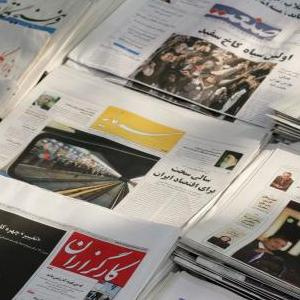Tehran’s Daily Newspaper Review

As Islamist students ravaged the British Embassy in Tehran, newspapers were preparing for their hottest diplomatic news of the year. Iran’s newspapers were decorated by pictures of angry demonstrators climbing up the walls of the embassy in central Tehran. The strongest headline predictably belonged Vatan-e Emrooz, while Tehran-e Emrooz also spoke of the “Students’ Rage”. The government’s official newspaper, Iran, did not appear as happy about the event, or so the placement of the news on the front page suggested.
Iran preferred to speak of the country’s “export leap” under sanctions, with a 40% increase in exports and six percent fall in imports. Iran also did not miss the opportunity to attack the office of potential presidential candidate Mohammad-Baqer Qalibaf, as it reported of Tehran Municipality officers beating the homeless on Tuesday, using cables and truncheons. The news was confirmed by the legal advisor to the municipality, Mohammad Taghavi. Ramin Mehmanparast’s condemnation was juxtaposed immediately below the headline on the UK Embassy’s seizure by students.
The facts and figures on the giant leap in exports found a different configuration in Jomhouri-ye Eslami’s front page, as the newspaper spoke of 27.4 billion dollars worth of exports vis-à-vis 39.7 billion dollars of imports, emphasizing the deficit rather than the export growth. Students’ takeover of the embassy was published in large font on the front page of Jomhouri-ye Eslami. In the meantime, the newspaper also spoke of “a new round of hostility” against Iran following the US-EU joint communiqué promising further pressures against Tehran.
Kayhan’s top headline was the victory of Islamists in Egypt’s parliamentary election. Kayhan also reported of a secret meeting between Qatar, France, the US, and Turkey in which, according to the newspaper, Qatar has promised to fund the military assault on Syria. Kayhan adopted a supportive tone for the seizure of the British Embassy, attributing it to the “fury of the Iranian nation with the colonialist policies of the British government.” The Iranian parliament will submit a file on US’ violation of human rights to the United Nations, the newspaper reported.
“Angry Students Enter Britain’s Den of Espionage on the Anniversary of the Inconsolable Martyrdom of [Iranian Nuclear Scientist] Martyr Shahriari” Resalat published on its front page. The repercussion of the Islamist students’ revolutionary move in the foreign media was also reviewed by the newspaper.
Shargh’s headline for the embassy takeover was the most moderate –and it could have been actually critical had the event taken place during the Reform Era-- i.e. “Protestors act against the British Embassy.” The news’ photo was quite symbolic: a young, bearded student holding upside-down a picture of Queen Elizabeth –taken from inside the embassy, beside him a black “Ya Hossein” flag, as Iranians are mourning the death of the third Shi’a Imam, Hussein (AS), an iconic anti-tyranny figure for the Shi’a world.
Tehran-e Emrooz chose the headline “the day of student rage” for the incident. The Iranian parliament took another step to pressurize Ahmadinejad’s government, scheduling a hearing session for an investigative report on the record of a highly controversial governmental department, i.e. The Supreme Council of Expatriate Iranians’ Affairs, once presided by Ahmadinejad’s controversial confidante Esfandiar Rahim Mashaei, which, according to anti-Mashaei figures, “serves as the operation arm of the Astray Current”, merely spending lavish budgets.
“The Den of the Fox Seized”, Vatan-e Emrooz proudly stated, covering the upper fold of the front page with a large picture of students entering the embassy of Britain –known as “The Old Fox” in Iran’s revolutionary terminology- defying the resistance of police forces. Scuffles between Lebanese and Israeli troops on their border, end of the first stage of parliamentary elections in Egypt and “the US’ elite’s despair with containing the wave of awakening” in their country also appeared on Vatan-e Emrooz’ front page.
* Notes:
The editorial section of Iranian newspapers is not the work of the editor-in-chief or the senior editorial staff of the newspaper by default, but can be a contribution by experts and politicians (typically agreeing with the newspaper’s political stance.) The newspapers may also occasionally publish without an editorial.
Vatan-e Emrooz daily does not publish on Thursdays.
Trouble with understanding some terms? Check our Glossary of Iranian Political Terms.
Briefing
Iran is the official organ of the administration. Its current editor-in-chief is Ali-Akbar Javanfekr, former media advisor to President Mahmoud Ahmadinejad.
Jomhouri-ye Eslami (The Islamic Republic) was known as the official organ of the Party of the Islamic Republic, founded in 1979 and disbanded in 1987. Currently, it is an open critique of Mahmoud Ahmadinejad's policies and is known to be a mouthpiece of Akbar Hashemi Rafsanjani.
Kayhan (Universe) is a hard-line conservative newspaper. Its editor-in-chief –currently Hossein Shari’atmadari- is directly appointed by Iran's Supreme Leader. Shari’atmadari’s editorials often spark off controversy and debate inside Iranian political circles.
Resalat (Mission) belongs to the moderate wing of the Principlist camp. Resalat’s best known analyst is Amir Mohebbian, its political editor.
Shargh (East) is a moderate Reformist newspaper. It was the most popular and influential Reformist newspaper in its first period of publication which lasted from August 2003 until September 2006.
Tehran-e Emrooz (Tehran Today) is a “Principlist/Reformist” newspaper, connected to Mohammad Baqer Qalibaf, Tehran Mayor and a likely candidate of the 2013 presidential election.
Vatan-e Emrooz (Motherland Today) is a supporter of the president’s policies.

